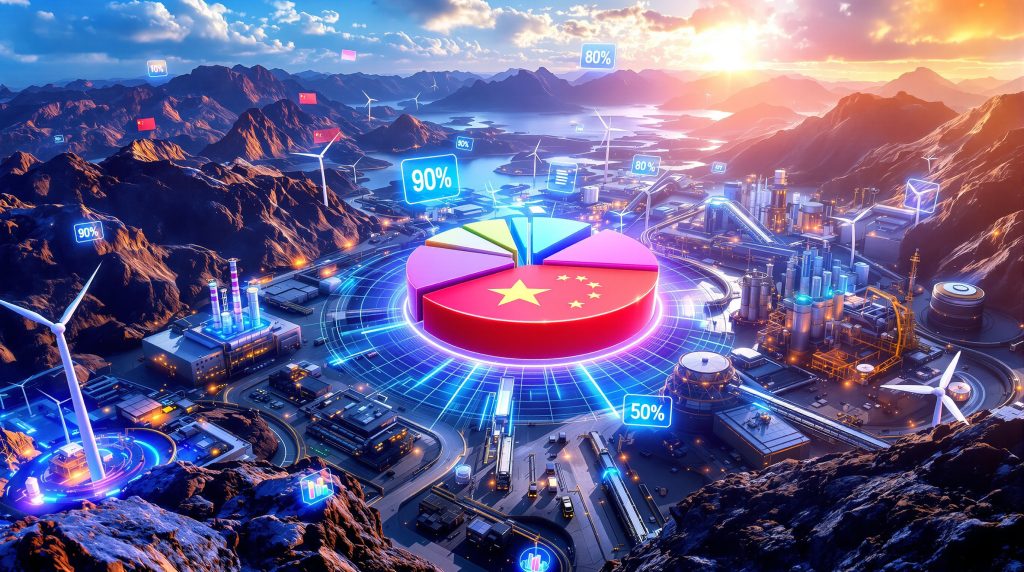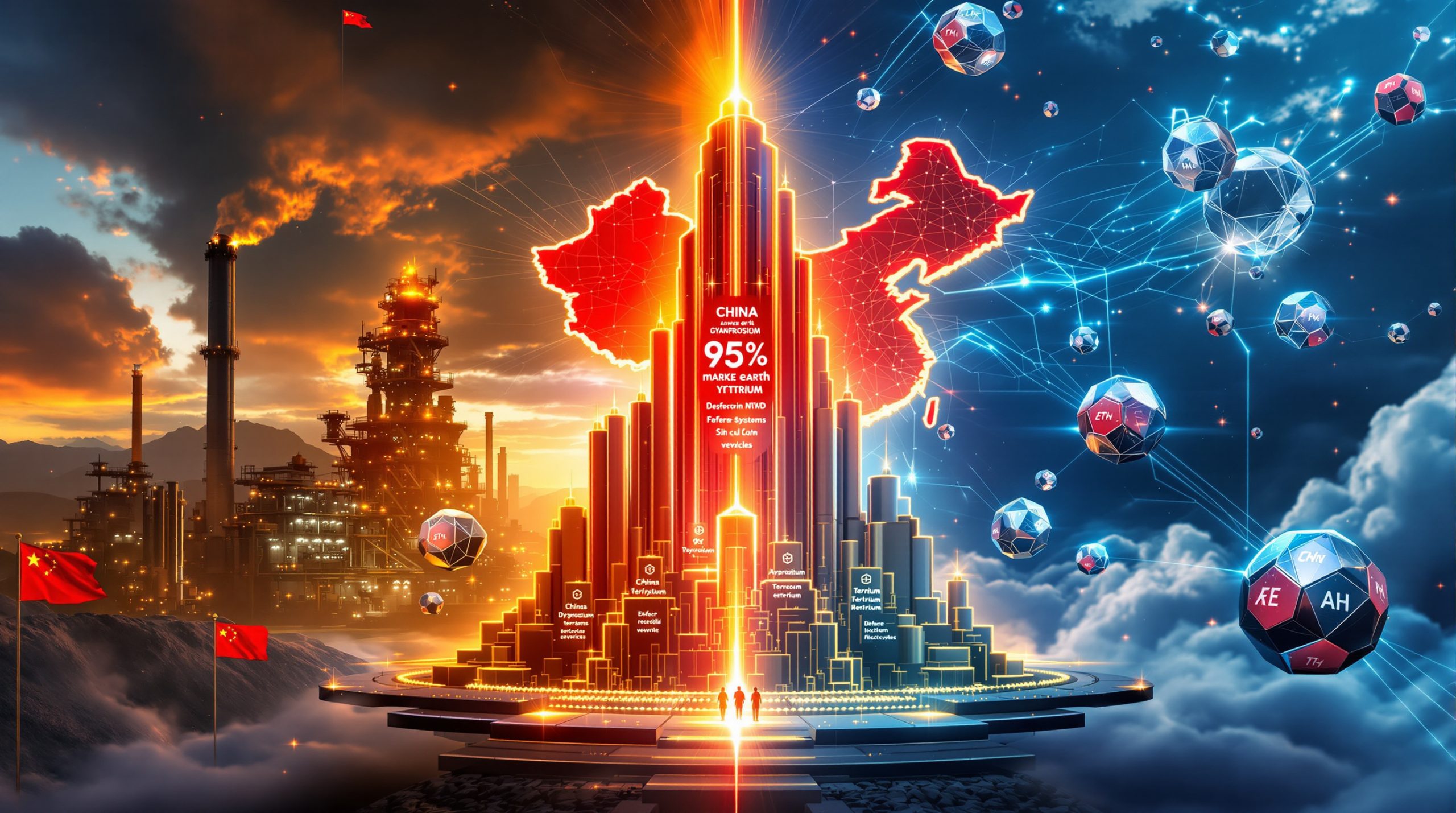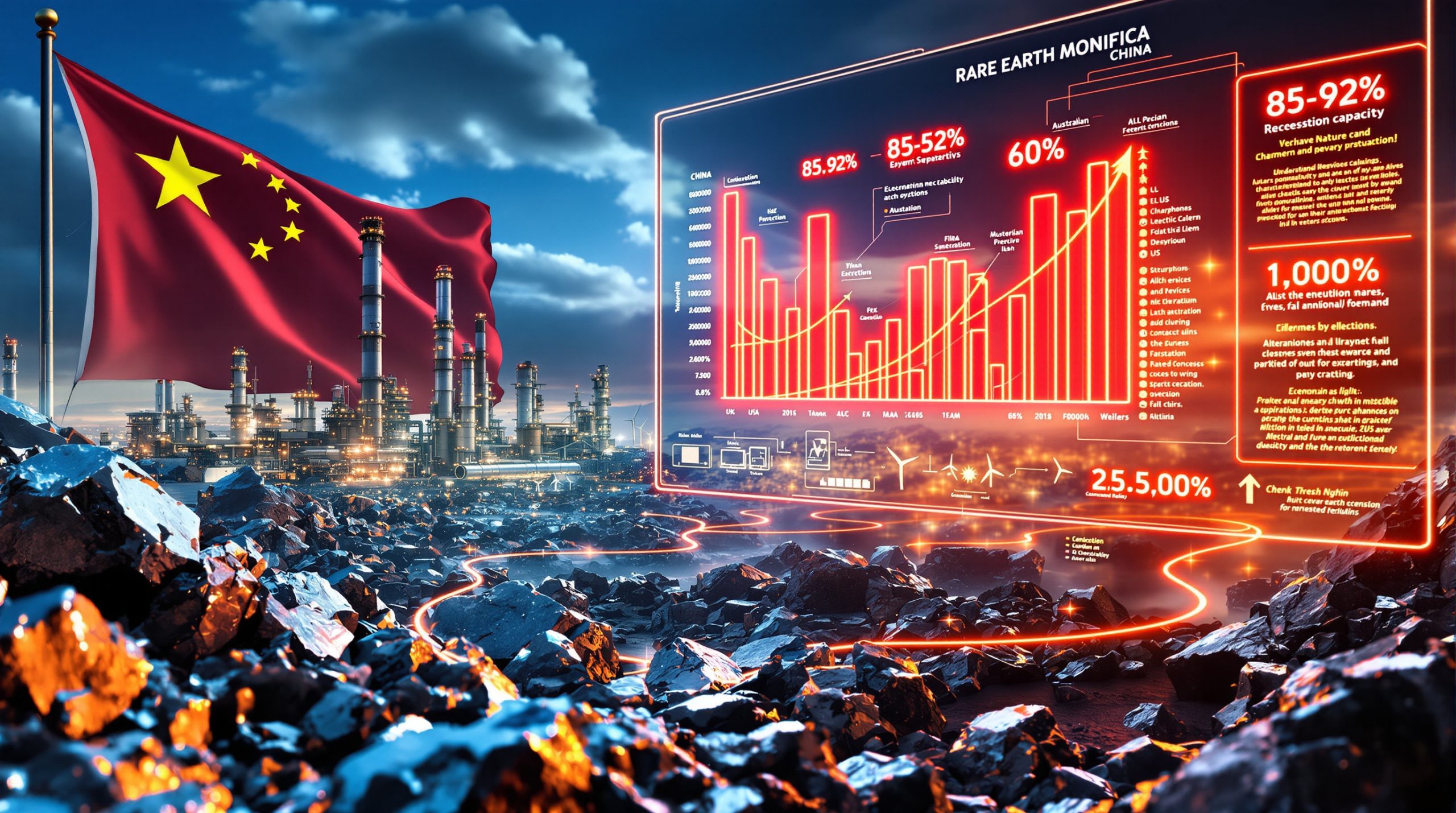Why Rare Earths Form the Cornerstone of China's Economic Dominance
China and rare earths represent far more than simple mining commodities in today's interconnected global economy. These 17 chemically similar metals, including neodymium, dysprosium, and terbium, serve as the invisible backbone supporting virtually every piece of modern technology. From the permanent magnets powering electric vehicle motors to the phosphors illuminating smartphone screens, rare earths enable the digital transformation reshaping industries worldwide.
Furthermore, China recognised this strategic importance decades ago, positioning itself as the undisputed leader in rare earth extraction and processing. Today, the nation controls approximately 70% of global mining output and an overwhelming 85-90% of global refining capacity, according to the International Energy Agency's 2023 Critical Minerals Market Review. This dominance extends beyond raw production to encompass the entire value chain, with Chinese facilities producing over 90% of rare earth permanent magnets globally.
| Stage | China's Global Share (%) |
|---|---|
| Mining | 70% |
| Processing/Refining | 87% |
| Magnet Production | 90%+ |
The strategic nature of this control becomes evident when examining the rare earth reserves distribution globally. While China holds approximately 44 million metric tons of rare earth reserves representing 35% of the global total, other nations possess substantial untapped resources. Vietnam contains 22 million metric tons, Brazil holds 21 million metric tons, and Russia maintains 21 million metric tons of reserves, according to the U.S. Geological Survey's 2024 Mineral Commodity Summaries.
However, reserves alone fail to translate into market influence without processing capabilities. The complexity of rare earth refining requires specialised knowledge accumulated over generations. Modern separation facilities employ 500-1,000 stages of solvent extraction to achieve the high-purity materials demanded by advanced technologies. This technical expertise, combined with integrated supply chains developed over four decades, creates formidable barriers for potential competitors.
Michael Silver, CEO and Chairman of American Elements, emphasised during a recent CNBC interview that China views rare earths as a national treasure, integrating these materials into comprehensive strategic planning frameworks. "This perspective manifests in policy decisions treating rare earths as instruments of both economic development and geopolitical influence."
How Export Controls Reshape Global Manufacturing Networks
China's willingness to leverage rare earth exports as policy tools became starkly apparent during the 2010 diplomatic crisis with Japan. Following a maritime dispute in the East China Sea, China reduced export quotas by approximately 40%, causing neodymium oxide prices to skyrocket from $15 per kilogram to over $300 per kilogram within 18 months.
More recent policy developments demonstrate continued strategic use of export controls. In December 2023, China implemented licensing requirements for certain rare earth smelting and separation technologies, adding bureaucratic hurdles that can extend processing times from 30 to 90 days. These measures complement earlier restrictions on gallium and germanium exports, signalling broader willingness to employ critical mineral controls.
The ripple effects extend throughout global supply chains in measurable ways:
- Price volatility increased by 180% during restriction periods compared to baseline conditions, according to Shanghai Rare Earth Exchange data
- European manufacturers now maintain 3-6 month stockpiles of critical materials, significantly increasing working capital requirements
- Approximately 95% of rare earth materials used in U.S. defence applications trace back to Chinese sources, creating substantial security vulnerabilities
Consequently, the 2014 World Trade Organisation ruling against China's export quotas proved largely symbolic, as subsequent production quotas and environmental regulations achieved similar supply control effects without violating international trade agreements.
Industry participants report that even temporary licensing delays can disrupt manufacturing schedules. In early 2024, European electric motor manufacturers experienced production slowdowns due to dysprosium oxide export permit delays, highlighting the fragility of just-in-time supply chains dependent on Chinese materials.
Western Nations Race to Build Alternative Supply Chains
Recognition of strategic vulnerability has triggered unprecedented investment in rare earth supply chain diversification across Western nations. The United States has committed substantial resources through multiple legislative initiatives, including $35 million allocated to MP Materials under the Defense Production Act and $140 million designated for demonstration facilities through the Infrastructure Investment and Jobs Act.
Australia leads non-Chinese production efforts with several significant projects advancing toward commercial operation:
- Lynas Rare Earths operates the only major processing facility outside China, producing approximately 12,000 metric tons of neodymium-praseodymium annually in Malaysia
- Iluka Resources received A$1.25 billion in government support for its Eneabba refinery project, targeting first production in 2026-2027
- Multiple exploration companies are evaluating rare earth potential at existing mining operations
The european supply chain initiative established ambitious targets through its 2023 Critical Raw Materials Act, aiming for 10% of annual consumption from EU extraction and 40% from EU processing by 2030. Supporting this goal, the bloc allocated €1.2 billion under the Horizon Europe program for critical materials projects spanning 2021-2027.
However, technical and economic challenges complicate these diversification efforts:
Timeline Reality:
- Complete supply chain establishment requires 10-15 years and sustained investment of $10-15 billion, according to U.S. Government Accountability Office analysis
- New refining facilities require $500 million to $1 billion in capital investment
- Environmental permitting processes can extend 3-5 years before construction begins
Competitive Disadvantages:
- Chinese processing benefits from 40-60% lower labour costs compared to Western facilities
- Integrated supply chains reduce transportation expenses
- Historical environmental compliance costs remained minimal in Chinese operations
- Economy of scale advantages accumulated over decades
Despite these challenges, strategic partnerships are emerging to accelerate development. The Australia-Japan Critical Minerals Partnership includes A$2 billion in Japanese financing for Australian projects, whilst the Five Eyes alliance established a Critical Minerals Working Group to coordinate supply chain initiatives.
Environmental Legacy Complicates Industry Expansion
Rare earth mining and processing generate significant environmental consequences that Western regulations address more stringently than historical Chinese practices. Each metric ton of rare earth oxides produced creates approximately 2,000-3,000 cubic metres of acidic wastewater containing dissolved heavy metals and chemical processing agents.
The radioactive component presents additional complexity. Rare earth ores naturally contain thorium-232 and uranium-238, producing tailings with specific activity levels ranging from 0.3 to 30 becquerels per gram depending on ore composition. In addition, China's Bayan Obo mining district has accumulated an estimated 200 million tons of such tailings over six decades of operation.
Environmental compliance costs create competitive disadvantages for new projects in regulated jurisdictions. Establishing environmental controls for rare earth processing facilities in the United States costs an estimated 30-40% more than equivalent Chinese operations, according to Resources Policy journal analysis. These additional expenses, combined with stricter permitting requirements, extend project development timelines significantly.
The Jiangxi Province experience illustrates potential consequences of inadequate environmental management. China's Ministry of Environmental Protection documented contamination in approximately 10% of agricultural land in rare earth mining regions by 2011, prompting remediation efforts costing billions of yuan.
Western projects must balance environmental stewardship with commercial viability, often resulting in higher production costs that challenge competitiveness against Chinese alternatives. This dynamic explains why many proposed rare earth projects outside China struggle to attract sufficient financing despite strategic importance.
Technology Sectors Face Asymmetric Supply Vulnerabilities
The concentration of rare earth supply creates asymmetric risks across technology sectors, with some industries facing existential threats from supply disruptions whilst others maintain viable alternatives. Electric vehicle manufacturing represents the most vulnerable sector, requiring substantial quantities of neodymium, praseodymium, dysprosium, and terbium for permanent magnet motors.
Critical Dependencies by Sector:
| End Use Sector | China Reliance (%) | Critical REEs Required |
|---|---|---|
| Electric Vehicles | 80% | Nd, Pr, Dy, Tb |
| Wind Energy | 60% | Nd, Dy |
| Military Technology | 85% | Sm, Nd, Dy |
| Consumer Electronics | 75% | La, Ce, Eu, Y |
Electric vehicle manufacturers face particular challenges because motor efficiency directly correlates with magnet quality. Neodymium-iron-boron magnets containing dysprosium maintain magnetic properties at the elevated temperatures generated during vehicle operation, making substitution extremely difficult without performance compromises.
Wind energy systems present similar vulnerabilities, though some manufacturers have developed alternative designs. Direct-drive wind turbines require powerful permanent magnets containing 200-600 kilograms of neodymium per megawatt of capacity, whilst gear-driven systems can utilise conventional electromagnets with reduced rare earth content.
Defence applications create national security implications extending beyond commercial considerations. Advanced radar systems, precision-guided munitions, and electronic warfare equipment depend on specific rare earth elements for optimal performance. The concentration of these materials in Chinese supply chains raises strategic concerns about potential supply disruptions during geopolitical tensions, making defense critical materials a priority for Western nations.
Innovation Efforts Target Supply Chain Independence
Technological innovation offers potential pathways toward reduced rare earth dependence, though commercial viability remains limited for most alternatives. Research initiatives span multiple approaches, from synthetic material development to advanced recycling techniques that could supplement primary production.
Emerging Technologies:
- Synthetic magnet research explores iron-nitride and manganese-based alternatives to neodymium magnets, though current prototypes achieve only 60-70% of conventional magnetic strength
- Urban mining initiatives target rare earth recovery from discarded electronics, with pilot projects achieving 15-20% recovery rates from smartphones and hard drives
- Biotechnology applications employ specialised bacteria and fungi to extract rare earths from low-grade ores, potentially reducing environmental impact
Government incentives have accelerated private sector investment in alternative technologies. The U.S. Department of Energy's ARPA-E program has funded dozens of rare earth substitute research projects, whilst European Union frameworks provide similar support for breakthrough technologies.
However, technical challenges limit near-term commercial deployment:
"Current synthetic alternatives cannot match the energy density and temperature stability of rare earth permanent magnets, making them unsuitable for demanding applications like electric vehicle motors and aerospace systems."
Recycling represents the most promising near-term alternative, though scale limitations constrain impact. Global electronic waste contains an estimated 320,000 metric tons of rare earth elements, yet current recycling recovers less than 1% of this potential supply. Improved collection systems and processing technologies could eventually provide 10-15% of global demand through secondary sources.
Strategic Implications for Global Technology Leadership
The intersection of rare earth supply chains and technological advancement creates profound implications for international economic competition. Nations controlling critical material access gain leverage over industries defining economic growth in the 21st century, from renewable energy to artificial intelligence hardware.
China and rare earths dominance extends beyond simple commodity control to encompass technological ecosystem leadership. Downstream industries including electric vehicle manufacturing, wind turbine production, and advanced electronics have concentrated in Chinese industrial clusters, leveraging proximity to raw material supplies and established manufacturing expertise.
The mining industry evolution reflects this broader shift toward strategic material control, as nations recognise the importance of securing supply chains for emerging technologies.
Strategic Considerations for Policymakers:
- Supply security requires balancing cost competitiveness with strategic independence
- Innovation investment must address both alternative materials and improved recycling technologies
- International cooperation can accelerate supply chain diversification whilst sharing development costs
- Regulatory frameworks need coordination to prevent regulatory arbitrage undermining environmental standards
The trajectory of rare earth supply chain evolution will influence technological leadership for decades. Countries successfully developing alternative supply sources may gain competitive advantages in emerging industries, whilst those remaining dependent on Chinese materials face ongoing strategic vulnerabilities.
Furthermore, the critical minerals energy transition demonstrates how China and rare earths control directly impacts global efforts to achieve renewable energy targets. This intersection creates additional urgency for supply chain diversification initiatives.
Market psychology currently favours diversification investments despite higher costs, as governments prioritise supply security over short-term economic efficiency. This shift suggests sustained support for alternative supply chain development even during periods of stable Chinese exports.
However, China's strategic use of rare earths as policy instruments continues to reshape international relationships and supply chain strategies. The ultimate resolution likely requires hybrid approaches combining domestic production capacity, strategic stockpiles, recycling infrastructure, and continued engagement with Chinese suppliers.
Success will depend on sustained political commitment, technological breakthrough achievements, and coordinated international cooperation to address one of the most complex supply chain challenges in modern industrial history. The stakes extend beyond economic considerations to encompass national security, environmental stewardship, and technological sovereignty in an increasingly interconnected world.
Disclaimer: This analysis contains forward-looking statements regarding market developments, policy changes, and technological progress. Actual results may vary significantly from projections discussed. Investment decisions should consider multiple factors including market volatility, regulatory changes, and geopolitical developments affecting rare earth supply chains.
Seeking Opportunities in Strategic Mineral Supply Chains?
Discovery Alert's proprietary Discovery IQ model delivers real-time notifications on significant ASX mineral discoveries, including critical materials that could reshape global supply chains and reduce strategic dependencies. Begin your 30-day free trial today and position yourself ahead of the market by identifying actionable opportunities before they reach mainstream attention.




